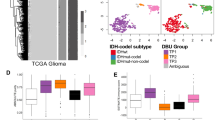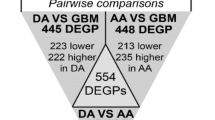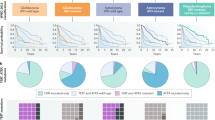Abstract
Primary brain tumors are a leading cause of cancer-related mortality among young adults and children. The most common primary malignant brain tumor, glioma, carries a median survival of only 14 months. Two major multi-institutional programs, the Glioma Molecular Diagnostic Initiative and The Cancer Genome Atlas, have pursued a comprehensive genomic characterization of a large number of clinical glioma samples using a variety of technologies to measure gene expression, chromosomal copy number alterations, somatic and germline mutations, DNA methylation, microRNA, and proteomic changes. Classification of gliomas on the basis of gene expression has revealed six major subtypes and provided insights into the underlying biology of each subtype. Integration of genome-wide data from different technologies has been used to identify many potential protein targets in this disease, while increasing the reliability and biological interpretability of results. Mapping genomic changes onto both known and inferred cellular networks represents the next level of analysis, and has yielded proteins with key roles in tumorigenesis. Ultimately, the information gained from these approaches will be used to create customized therapeutic regimens for each patient based on the unique genomic signature of the individual tumor. In this Review, we describe efforts to characterize gliomas using genomic data, and consider how insights gained from these analyses promise to increase understanding of the biological underpinnings of the disease and lead the way to new therapeutic strategies.
Key Points
-
Genomic analysis has revealed that gliomas fall into six subtypes, two of which have characteristics of oligodendrogliomas and four of which show poor survival
-
The glioma subtypes show distinct, but overlapping, patterns of mutations, copy number alterations, and gene expression
-
Integration of genomic data, such as gene expression, single nucleotide polymorphism chips, proteomics, microRNA, and epigenomics, increases the reliability and biological interpretability of results
-
Mapping of genomic data onto both known and inferred cellular networks reveals new insights into tumorigenesis
This is a preview of subscription content, access via your institution
Access options
Subscribe to this journal
Receive 12 print issues and online access
$209.00 per year
only $17.42 per issue
Buy this article
- Purchase on Springer Link
- Instant access to full article PDF
Prices may be subject to local taxes which are calculated during checkout




Similar content being viewed by others
References
Purow, B. & Schiff, D. Advances in the genetics of glioblastoma: are we reaching critical mass? Nat. Rev. Neurol. 5, 419–426 (2009).
Goodwin, C. R. & Laterra, J. Neuro-oncology: unmasking the multiforme in glioblastoma. Nat. Rev. Neurol. 6, 304–305 (2010).
Macdonald, T. J. et al. Expression profiling of medulloblastoma PDGFRA and the RAS/MAPK pathway. Nat. Genet. 29, 143–152 (2001).
Nagarajan, R. P. & Costello, J. F. Molecular epigenetics and genetics in neuro-oncology. Neurotherapeutics 6 436–446 (2009).
Robinson, J. P. et al. Activated BRAF induces gliomas in mice when combined with Ink4a/Arf loss or Akt activation. Oncogene 29, 335–344 (2010).
Nevins, J. R. & Potti, A. Mining gene expression profiles: expression signatures as cancer phenotypes. Nat. Rev. Genet. 8, 601–609 (2007).
Hedenfalk, I. et al. Gene-expression profiles in hereditary breast cancer. N. Engl. J. Med. 344, 539–548 (2001).
Sotiriou, C. et al. Breast cancer classification and prognosis based on gene expression profiles from a population-based study. Proc. Natl Acad. Sci. USA 100, 10393–10398 (2003).
Alizadeh, A. A. et al. Distinct types of diffuse large B-cell lymphoma identified by gene expression profiling. Nature 403, 503–511 (2000).
Institute for Genomics and Bioinformatics, University of California, Irvine. Cyber-T[online], (2010).
Tso, C.-L. et al. Distinct transcription profiles of primary and secondary glioblastoma subgroups. Cancer Res. 66, 159–167 (2006).
MacDonald, T. J. et al. Expression profiling of medulloblastoma: PDGFRA and the RAS/MAPK pathway as therapeutic targets for metastatic disease. Nat. Genet. 29, 143–152 (2001).
Sallinen, S. L. et al. Identification of differentially expressed genes in human gliomas by DNA microarray and tissue chip techniques. Cancer Res. 60, 6617–6622 (2000).
Rickman, D. S. et al. Distinctive molecular profiles of high-grade and low-grade gliomas based on oligonucleotide microarray analysis. Cancer Res. 61, 6885–6891 (2001).
Mischel, P. S. et al. Identification of molecular subtypes of glioblastoma by gene expression profiling. Oncogene 22, 2361–2373 (2003).
Shai, R. et al. Gene expression profiling identifies molecular subtypes of gliomas. Oncogene 22, 4918–4923 (2003).
Freije, W. A. et al. Gene expression profiling of gliomas strongly predicts survival. Cancer Res. 64, 6503–6510 (2004).
Tso, C. L. Distinct transcription profiles of primary and secondary glioblastoma subgroups. Cancer Res. 66, 159–167 (2006).
Tso, C. L. Primary glioblastomas express mesenchymal stem-like properties. Mol. Cancer Res. 4, 607–619 (2006).
Phillips, H. S. et al. Molecular subclasses of high-grade glioma predict prognosis, delineate a pattern of disease progression, and resemble stages in neurogenesis. Cancer Cell 9, 157–173 (2006).
Li, A. et al. Unsupervised analysis of transcriptomic profiles reveals six glioma subtypes. Cancer Res. 69, 2091–2099 (2009).
Li, A. et al. Genomic changes and gene expression profiles reveal that established glioma cell lines are poorly representative of primary human gliomas. Mol. Cancer Res. 6, 21–30 (2008).
Verhaak, R. G. W. et al. Integrated genomic analysis identifies clinically relevant subtypes of glioblastoma characterized by abnormalities in PDGFRA, IDH1, EGFR, and NF1. Cancer Cell 17, 98–110 (2010).
Liu, J. et al. Identification of a gene signature in cell cycle pathway for breast cancer prognosis using gene expression profiling data. BMC Med. Genomics 1, 39 (2008).
Beroukhim, R. et al. Assessing the significance of chromosomal aberrations in cancer: methodology and application to glioma. Proc. Natl Acad. Sci. USA 104, 20007–20012 (2007).
Freire, P. et al. Exploratory analysis of the copy number alterations in glioblastoma multiforme. PLoS ONE 3, e4076 (2008).
de Tayrac, M. et al. Integrative genome-wide analysis reveals a robust genomic glioblastoma signature associated with copy number driving changes in gene expression. Genes Chromosomes Cancer 48, 55–68 (2009).
Kotliarov, Y. et al. CNAReporter: a GenePattern pipeline for the generation of clinical reports of genomic alterations. BMC Med. Genomics 3, 11 (2010).
Kotliarov, Y. et al. Correlation analysis between single-nucleotide polymorphism and expression arrays in gliomas identifies potentially relevant target genes. Cancer Res. 69, 1596–1603 (2009).
Bredel, M. et al. A network model of a cooperative genetic landscape in brain tumors. JAMA 302, 261–275 (2009).
Wrensch, M. et al. Variants in the CDKN2B and RTEL1 regions are associated with high-grade glioma susceptibility. Nat. Genet. 41, 905–908 (2009).
Shete, S. et al. Genome-wide association study identifies five susceptibility loci for glioma. Nat. Genet. 41, 899–904 (2009).
LaFramboise, T., Dewal, N., Wilkins, K., Pe'er, I. & Freedman, M. L. Allelic selection of amplicons in glioblastoma revealed by combining somatic and germline analysis. PLoS Genet. 6, e1001086 (2010).
Asadi-Moghaddam, K., Chiocca, E. A. & Lawler, S. E. Potential role of miRNAs and their inhibitors in glioma treatment. Expert Rev. Anticancer Ther. 10, 1753–1762 (2010).
Chiocca, E. A. & Lawler, S. E. The many functions of microRNAs in glioblastoma. World Neurosurg. 73, 598–601 (2010).
Godlewski, J., Bronisz, A., Nowicki, M. O., Chiocca, E. A. & Lawler, S. microRNA-451: A conditional switch controlling glioma cell proliferation and migration. Cell Cycle 9, 2742–2748 (2010).
Godlewski, J., Newton, H. B., Chiocca, E. A. & Lawler, S. E. MicroRNAs and glioblastoma; the stem cell connection. Cell Death Differ. 17, 221–228 (2010).
Turner, J. D. et al. The many roles of microRNAs in brain tumor biology. Neurosurg. Focus 28, E3 (2010).
Dong, H. et al. Integrated analysis of mutations, miRNA and mRNA expression in glioblastoma. BMC Syst. Biol. 4, 163 (2010).
Wuchty, S. et al. Prediction of associations between microRNAs and gene expression in glioma biology. PLoS ONE 6, e14681 (2011).
Kim, T., Huang, W., Park, R., Park, P. J. & Johnson, M. D. A developmental taxonomy of glioblastoma defined and maintained by microRNAs. Cancer Res. 71, 3387–3399 (2011).
Cadieux, B., Ching, T. T., VandenBerg, S. R. & Costello, J. F. Genome-wide hypomethylation in human glioblastomas associated with specific copy number alteration, methylenetetrahydrofolate reductase allele status, and increased proliferation. Cancer Res. 66, 8469–8476 (2006).
Fanelli, M. et al. Loss of pericentromeric DNA methylation pattern in human glioblastoma is associated with altered DNA methyltransferases expression and involves the stem cell compartment. Oncogene 27, 358–365 (2008).
Alaminos, M. et al. EMP3, a myelin-related gene located in the critical 19q13.3 region, is epigenetically silenced and exhibits features of a candidate tumor suppressor in glioma and neuroblastoma. Cancer Res. 65, 2565–2571 (2005).
Amatya, V. J., Naumann, U., Weller, M. & Ohgaki, H. TP53 promoter methylation in human gliomas. Acta Neuropathol. 110, 178–184 (2005).
Baeza, N., Weller, M., Yonekawa, Y., Kleihues, P. & Ohgaki, H. PTEN methylation and expression in glioblastomas. Acta Neuropathol. 106, 479–485 (2003).
Costello, J. F., Berger, M. S., Huang, H. S. & Cavenee, W. K. Silencing of p16/CDKN2 expression in human gliomas by methylation and chromatin condensation. Cancer Res. 56, 2405–2410 (1996).
Dallol, A. et al. Frequent epigenetic inactivation of the SLIT2 gene in gliomas. Oncogene 22, 4611–4616 (2003).
Foltz, G. et al. DNA methyltransferase-mediated transcriptional silencing in malignant glioma: a combined whole-genome microarray and promoter array analysis. Oncogene 28, 2667–2677 (2009).
Hesson, L. et al. Frequent epigenetic inactivation of RASSF1A and BLU genes located within the critical 3p21.3 region in gliomas. Oncogene 23, 2408–2419 (2004).
Veeriah, S. et al. The tyrosine phosphatase PTPRD is a tumor suppressor that is frequently inactivated and mutated in glioblastoma and other human cancers. Proc. Natl Acad. Sci. USA 106, 9435–9440 (2009).
Mladkova, N. & Chakravarti, A. Molecular profiling in glioblastoma: prelude to personalized treatment. Curr. Oncol. Rep. 11, 53–61 (2009).
Noushmehr, H. et al. Identification of a CpG island methylator phenotype that defines a distinct subgroup of glioma. Cancer Cell 17, 510–522 (2010).
Kim, H. et al. Integrative genome analysis reveals an oncomir/oncogene cluster regulating glioblastoma survivorship. Proc. Natl Acad. Sci. USA 107, 2183–2188 (2010).
Niclou, S. P., Fack, F. & Rajcevic, U. Glioma proteomics: status and perspectives. J. Proteomics 73, 1823–1838 (2010).
Huang, P. H., Xu, A. M. & White, F. M. Oncogenic EGFR signaling networks in glioma. Science Signaling 2, re6 (2009).
Rich, J. N. et al. A genetically tractable model of human glioma formation. Cancer Res. 61, 3556–3560 (2001).
Deighton, R. F., McGregor, R., Kemp, J., McCulloch, J. & Whittle, I. R. Glioma pathophysiology: insights emerging from proteomics. Brain Pathol. 20, 691–703 (2010).
Brennan, C. et al. Glioblastoma subclasses can be defined by activity among signal transduction pathways and associated genomic alterations. PLoS ONE 4, e7752 (2009).
Du, J. et al. Bead-based profiling of tyrosine kinase phosphorylation identifies SRC as a potential target for glioblastoma therapy. Nat. Biotechnol. 27, 77–83 (2009).
Mir, S. E. et al. In silico analysis of kinase expression identifies WEE1 as a gatekeeper against mitotic catastrophe in glioblastoma. Cancer Cell 18, 244–257 (2010).
Kanehisha Laboratories. KEGG: Kyoto Encyclopedia of Genes and Genomes [online], (2010).
BioCarta. BioCarta Pathways [online], (2010).
Parsons, D. W. et al. An integrated genomic analysis of human glioblastoma multiforme. Science 321, 1807–1812 (2008).
Cerami, E., Demir, E., Schultz, N., Taylor, B. S. & Sander, C. Automated network analysis identifies core pathways in glioblastoma. PLoS ONE 5, e8918 (2010).
Beckner, M. E. et al. Identification of ATP citrate lyase as a positive regulator of glycolytic function in glioblastomas. Int. J. Cancer 126, 2282–2295 (2010).
Zheng, H. et al. PLAGL2 regulates Wnt signaling to impede differentiation in neural stem cells and gliomas. Cancer Cell 17, 497–509 (2010).
Wong, D. J. et al. Revealing targeted therapy for human cancer by gene module maps. Cancer Res. 68, 369–378 (2008).
Keller, A. et al. A novel algorithm for detecting differentially regulated paths based on gene set enrichment analysis. Bioinformatics 25, 2787–2794 (2009).
Bredel, M. et al. Functional network analysis reveals extended gliomagenesis pathway maps and three novel MYC-interacting genes in human gliomas. Cancer Res. 65, 8679–8689 (2005).
Wuchty, S. et al. Gene pathways and subnetworks distinguish between major glioma subtypes and elucidate potential underlying biology. J. Biomed. Inform. 43, 945–952 (2010).
Carro, M. S. et al. The transcriptional network for mesenchymal transformation of brain tumours. Nature 463, 318–325 (2009).
Bozdag, S., Li, A., Wuchty, S. & Fine, H. A. FastMEDUSA: a parallelized tool to infer gene regulatory networks. Bioinformatics 26, 1792–1793 (2010).
FANTOM Consortium et al. The transcriptional network that controls growth arrest and differentiation in a human myeloid leukemia cell line. Nat. Genet. 41, 553–562 (2009).
Cooper, L. A. D. et al. An integrative approach for in silico glioma research. IEEE Trans. Biomed. Eng. 57, 2617–2621 (2010).
National Cancer Institute. REMBRANDT database [online], (2010).
Madhavan, S. et al. Rembrandt: helping personalized medicine become a reality through integrative translational research. Mol. Cancer Res. 7, 157–167 (2009).
Li, A., Bozdag, S., Kotliarov, Y. & Fine, H. A. GliomaPredict: a clinically useful tool for assigning glioma patients to specific molecular subtypes. BMC Med. Inform. Decis. Mak. 10, 38 (2010).
National Cancer Institute. caArray [online], (2011).
National Cancer Institute. Cancer Genome Anatomy Project [online], (2011).
National Cancer Institute. Cancer Central Clinical Database [online], (2011).
National Cancer Institute. caCORE SDK [online], (2011).
National Cancer Institute. caBIG [online], (2011).
Broad Institute. GenePattern [online], (2011).
National Cancer Institute. The Cancer Genome Atlas [online], (2011).
CGAR Network. Comprehensive genomic characterization defines human glioblastoma genes and core pathways. Nature. 4 55, 1061–1068 (2008).
Jones, A. R. et al. The Functional Genomics Experiment model (FuGE): an extensible framework for standards in functional genomics. Nat. Biotechnol. 25, 1127–1133 (2007).
Fenstermacher, D. et al. The Cancer Biomedical Informatics Grid (caBIG). Conf. Proc. IEEE Eng. Med. Biol. Soc. 1, 743–746 (2005).
Kakazu, K. K., Cheung, L. W. K. & Lynne, W. The Cancer Biomedical Informatics Grid (caBIG): pioneering an expansive network of information and tools for collaborative cancer research. Hawaii Med. J. 63, 273–275 (2004).
Deus, H. F. et al. Exposing the Cancer Genome Atlas as a SPARQL endpoint. J. Biomed. Inform. 43, 998–1008 (2010).
Gadaleta, E., Lemoine, N. R. & Chelala, C. Online resources of cancer data: barriers, benefits and lessons. Brief. Bioinform. 12, 52–63 (2010).
Ovaska, K. et al. Large-scale data integration framework provides a comprehensive view on glioblastoma multiforme. Genome Med. 2, 65 (2010).
Schadt, E. E., Friend, S. H. & Shaywitz, D. A. A network view of disease and compound screening. Nat. Rev. Drug Discov. 8, 286–295 (2009).
Colman, H. et al. A multigene predictor of outcome in glioblastoma. Neuro Oncol. 12, 49–57 (2010).
Staunton, J. E. et al. Chemosensitivity prediction by transcriptional profiling. Proc. Natl Acad. Sci. USA 98, 10787–10792 (2001).
Lee, J. K. et al. A strategy for predicting the chemosensitivity of human cancers and its application to drug discovery. Proc. Natl Acad. Sci. USA 104, 13086–13091 (2007).
Sos, M. L. et al. Predicting drug susceptibility of non-small cell lung cancers based on genetic lesions. J. Clin. Invest. 119, 1727–1740 (2009).
Wallqvist, A., Rabow, A. A., Shoemaker, R. H., Sausville, E. A. & Covell, D. G. Establishing connections between microarray expression data and chemotherapeutic cancer pharmacology. Mol. Cancer Ther. 1, 311–320 (2002).
McDermott, U. et al. Identification of genotype-correlated sensitivity to selective kinase inhibitors by using high-throughput tumor cell line profiling. Proc. Natl Acad. Sci. USA 104, 19936–19941 (2007).
Riddick, G. et al. Predicting in vitro drug sensitivity using Random Forests. Bioinformatics 27, 220–224 (2011).
Mori, S., Chang, J. T., Andrechek, E. R., Potti, A. & Nevins, J. R. Utilization of genomic signatures to identify phenotype-specific drugs. PLoS ONE 4, e6772 (2009).
Nelander, S. et al. Models from experiments: combinatorial drug perturbations of cancer cells. Mol. Syst. Biol. 4, 216 (2008).
Ring, B. Z., Chang, S., Ring, L. W., Seitz, R. S. & Ross, D. T. Gene expression patterns within cell lines are predictive of chemosensitivity. BMC Genomics 9, 74 (2008).
Hahn, C. K. et al. Expression-based screening identifies the combination of histone deacetylase inhibitors and retinoids for neuroblastoma differentiation. Proc. Natl Acad. Sci. USA 105, 9751–9756 (2008).
Kamb, A., Wee, S. & Lengauer, C. Why is cancer drug discovery so difficult? Nat. Rev. Drug Discov. 6, 115–120 (2007).
Wiedemeyer, W. R. et al. Pattern of retinoblastoma pathway inactivation dictates response to CDK4/6 inhibition in GBM. Proc. Natl Acad. Sci. USA 107, 11501–11506 (2010).
Diehn, M. et al. Identification of noninvasive imaging surrogates for brain tumor gene-expression modules. Proc. Natl Acad. Sci. USA 105, 5213–5218 (2008).
Segal, E. et al. Decoding global gene expression programs in liver cancer by noninvasive imaging. Nat. Biotechnol. 25, 675–680 (2007).
Author information
Authors and Affiliations
Contributions
Both authors contributed equally to researching, discussing, writing, reviewing and editing this manuscript.
Corresponding author
Ethics declarations
Competing interests
The authors declare no competing financial interests.
Rights and permissions
About this article
Cite this article
Riddick, G., Fine, H. Integration and analysis of genome-scale data from gliomas. Nat Rev Neurol 7, 439–450 (2011). https://doi.org/10.1038/nrneurol.2011.100
Published:
Issue Date:
DOI: https://doi.org/10.1038/nrneurol.2011.100
This article is cited by
-
Recent insights into the microRNA-dependent modulation of gliomas from pathogenesis to diagnosis and treatment
Cellular & Molecular Biology Letters (2022)
-
HECTD3 regulates the tumourigenesis of glioblastoma by polyubiquitinating PARP1 and activating EGFR signalling pathway
British Journal of Cancer (2022)
-
The Role of the Ubiquitin Proteasome System in Glioma: Analysis Emphasizing the Main Molecular Players and Therapeutic Strategies Identified in Glioblastoma Multiforme
Molecular Neurobiology (2021)
-
Modelling genetic mosaicism of neurodevelopmental disorders in vivo by a Cre-amplifying fluorescent reporter
Nature Communications (2020)
-
TRIP13 promotes the cell proliferation, migration and invasion of glioblastoma through the FBXW7/c-MYC axis
British Journal of Cancer (2019)



